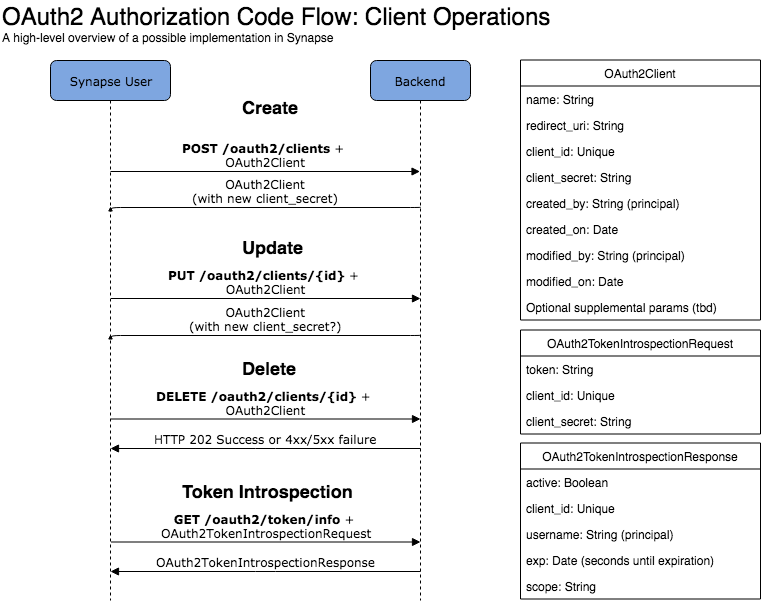| Table of Contents |
|---|
...
| Verb | Endpoint | Purpose | Request | Response | Notes |
|---|---|---|---|---|---|
| GET | /oauth2/client/{id} | Get details about one client | Path param: id: an existing OAuth2 Client ID | OAuth2Client name: String redirect_uri: String client_id: Unique created_by/on modified_by/on | Only the owner or a Synapse admin can make this request. |
| GET | /oauth2/client/ | List clients created by user | List of above. | Don't return secret. | |
| POST | /oauth2/client | Create a client | OAuth2Client name: String redirect_uri: String Supplemental params | OAuth2Client name: String redirect_uri: String client_id: Unique client_secret: String created_by/on modified_by/on | Supplemental params could include the URL to a logo, link to a website for the app, terms of service, etc. See https://openid.net/specs/openid-connect-registration-1_0.html Typically the secret key is used to perform these actions, but if we give Synapse users a claim over an OAuth2 client, we could use their credentials. |
| DELETE | /oauth2/client/{id} | Delete a client | Path param: id: an existing OAuth2 Client ID | None | |
| PUT | /oauth2/client/{id} | Update a client | OAuth2Client name: String redirect_uri: String Supplemental params | OAuth2Client name: String redirect_uri: String client_id: Unique created_by/on modified_by/on Supplemental params | Typically the secret key is used to perform these actions, but if we give Synapse users a claim over an OAuth2 client, we could use their credentials. |
...
| Verb | Endpoint | Purpose | Request Object/Params | Response Object/Params | Notes |
|---|---|---|---|---|---|
| POST | /login/scoped | Get a scoped access token | sessionToken: String scope: String | scopedLoginResponse: scopedSessionToken: String acceptsTermsOfUse: Boolean scope: String exp: Integer (seconds until expiry) | This is a more secure alternative to the current session token as limits what can be done with the session token. These can (should?) expire quickly (minutes-hours). This could be done by passing in username and password rather than sessionToken, but we'd have to handle the case where the user has no password and logs in via Google (or other OAuth provider). |
| GET | /oauth2/details | Get human-interpretable details about the requesting client, and the scope that they are requesting | Parameters clientId: Unique (the ID of an existing OAuth2 client requesting access) scope: String | OAuth2Client scopes: Array<string> e.g. [("read", "syn123"), ("create","syn456")] (actual representation TBD) | The web layer can use this to get details about a client requesting authorization and the scope they request |
| POST | /oauth2/consent | The user grants access to the OAuth2 Client to access protected resources | URL Parameters: response_type: String (always "code") client_id: Unique redirect_uri: String (points to OAuth client) scope: String state: String | If scopedAccessToken is valid: Body: OAuthClientUrl: String redirect_uri?code={code}&state={state} (all provided in request) Parameters: code: the authorization code state: the same value in the request | Who should execute this? The User Agent or the Web Layer on behalf of the user agent? Question: how to handle with various Synapse IdPs? (E.g. Synapse users who sign in with Google accounts). The "state" parameter is designed to avoid CSRF attacks and the client must utilize it per RFC-6749 § 10.12. More info. |
| O
|
|
...
| Verb | Endpoint | Purpose | Request | Response | Notes |
|---|---|---|---|---|---|
| GET | /.well-known/openid-configuration | return metadata about the service | N/A | See spec -→ Key elements are:
| https://openid.net/specs/openid-connect-discovery-1_0.html#ProviderConfigurationRespon |
| GET | /oauth2/userinfo | return information about the user | N/A | Body: sub: "subject", Synapse user id aud: "audience", the OAuth client ID iat: "issued at", the timestamp when the response was created given_name: first name family_name: last name | https://openid.net/specs/openid-connect-basic-1_0.html#UserInfo Note: content type must be application/jwt as per https://openid.net/specs/openid-connect-core-1_0.html#UserInfoResponse |
| POST | /oauth2/userinfo | as above | N/A | as above | Although GET is the recommended HTTP method, POST must be supported, as per https://openid.net/specs/openid-connect-core-1_0.html#UserInfo |
...
Diagrams to show where these API endpoints would be used and what objects/params are needed:
How do we know if we're up-to-spec when we are done?
...
The administrative port should not be exposed to public internet traffic. If you want to expose certain endpoints, such as the
/clientsendpoint for OpenID Connect Dynamic Client Registry, you can do so but you need to properly secure these endpoints with an API Gateway or Authorization Proxy.
Do we need this?
Spring Security
...

.png?version=1&modificationDate=1564589737737&cacheVersion=1&api=v2)
